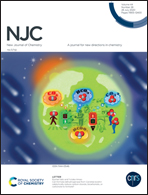Highly enhanced bifunctional electrocatalytic activity of mixed copper–copper oxides on nickel foam via composition control†
Abstract
Developing an efficient transition metal-based non-noble electrocatalyst is important for the industrial water splitting process and producing green sustainable hydrogen (H2) fuel. Particularly, the direct fabrication of electrocatalysts on an electrode surface can exhibit strong electronic coupling that results in increased catalytic activity. Herein, copper (Cu) and cuprous oxide (Cu2O) nanoparticles were directly deposited on a nickel foam (NF) substrate and the controlled calcination of the Cu produced mixed copper–copper oxides (CuO, Cu2O–CuO and Cu–Cu2O–CuO) that exhibited excellent composition-controlled bifunctional electrocatalytic (oxygen evolution reaction (OER) and hydrogen evolution reaction (HER)) activity in an alkaline medium with good stability. Powder X-ray diffraction (PXRD) and X-ray photoelectron spectroscopic (XPS) studies confirmed the formation of pure and mixed copper–copper oxide nanomaterials on NF. Mixed copper oxide (Cu2O–CuO@NF) and pure CuO@NF exhibited excellent electrocatalytic OER and HER activity, respectively, in alkaline media. To the best of our knowledge, Cu2O–CuO@NF required an overpotential of 262 mV to achieve the lowest geometric current density (10 mA cm−2) among the pure copper-based electrocatalysts reported. Cu2O–CuO@NF also produced a high current density (130.9 mA cm−2) at a relatively low applied potential (1.56 V) compared to other catalysts. The low Tafel slope (45.8 mV dec−1) and charge-transfer resistance indicated that good electronic coupling and fast charge transport led to the higher activity. In the HER, pure CuO@NF required a much lower overpotential of 165 mV to produce geometric current density. It is worth noting that CuO@NF showed strong HER activity in the alkaline medium. The Tafel slope of 121.81 mV dec−1 for CuO@NF suggests that the desorption process could be the rate-determining step in the HER process. Cu2O–CuO@NF and CuO@NF exhibited good stability in the alkaline medium. The highly enhanced current density and good stability of Cu2O–CuO@NF in 6.0 M KOH at 60 °C highlights its potential for practical applications. Overall, an earth-abundant copper-based electrocatalyst with excellent OER and HER activity in alkaline media has been developed by directly fabricating on a conducting substrate and controlling the copper oxides composition.



 Please wait while we load your content...
Please wait while we load your content...